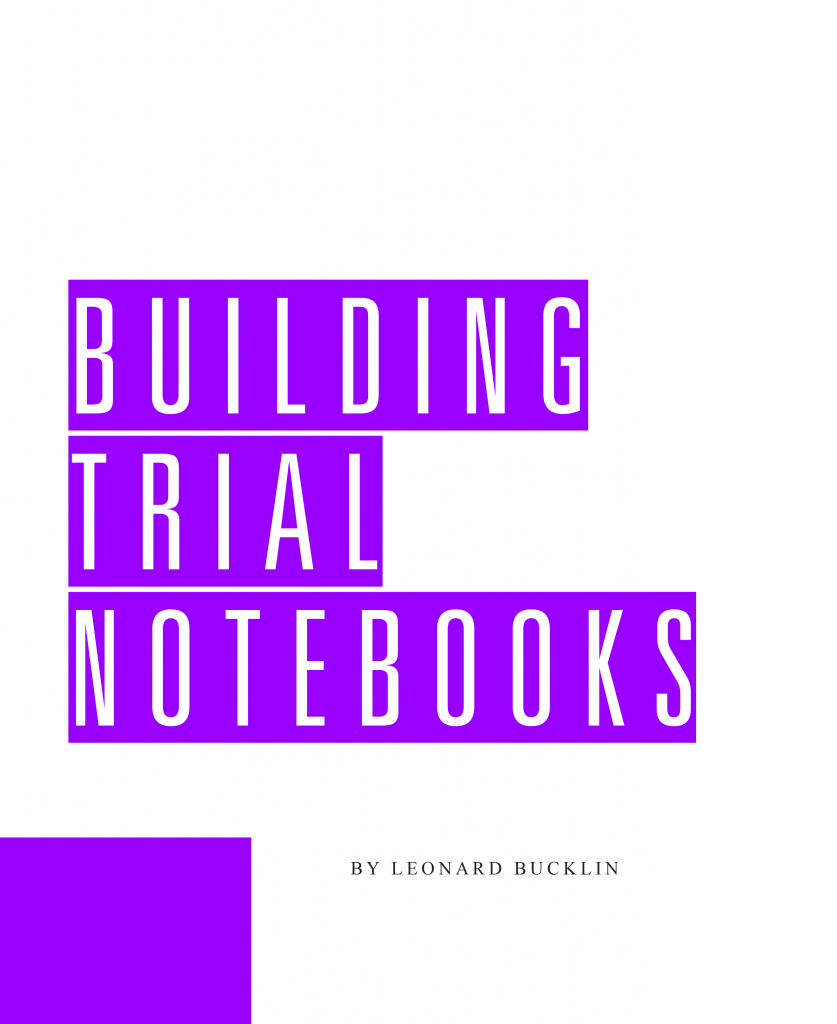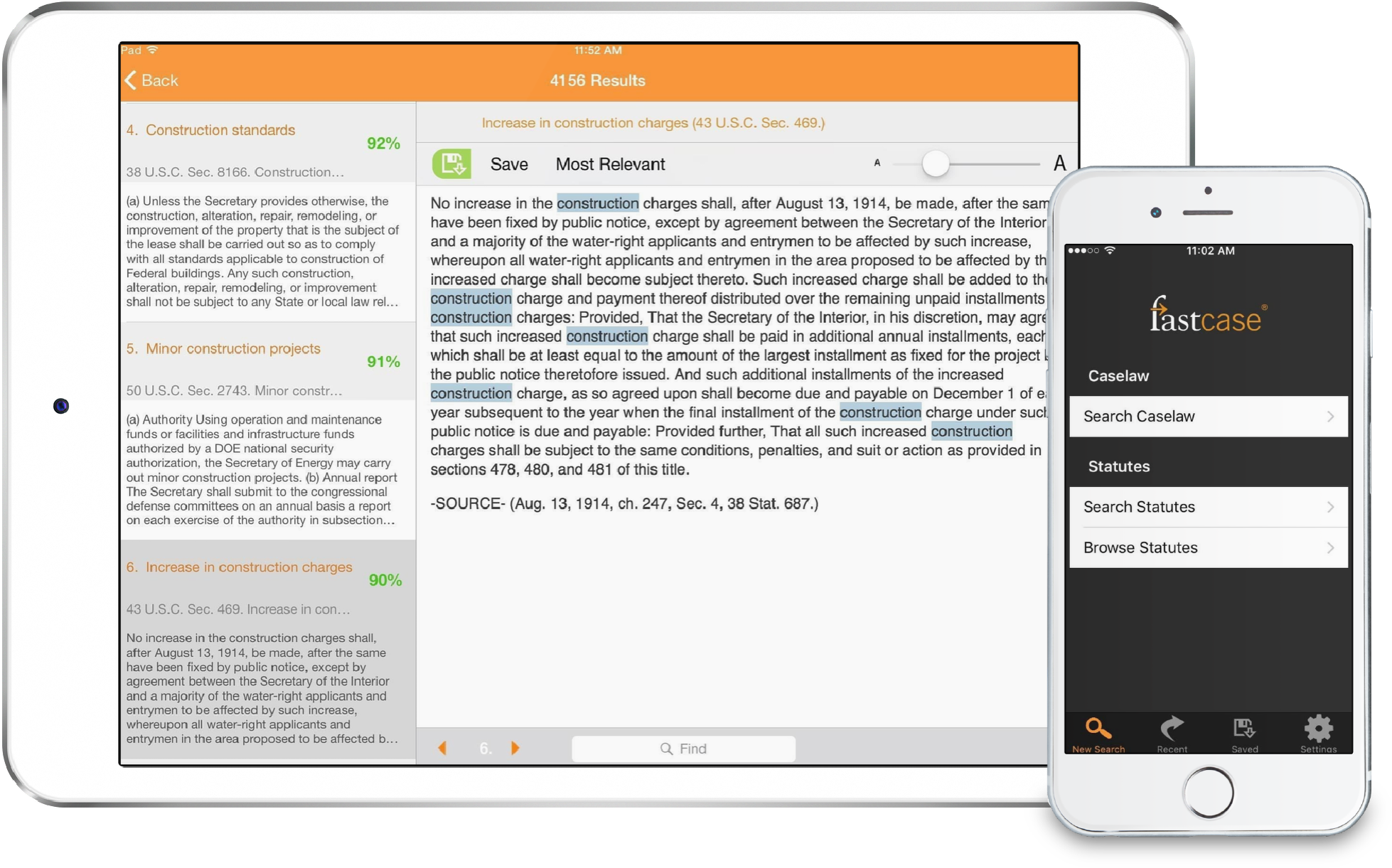Building Trial Notebooks

Table of Contents
Volume 1 – Building Trial Notebooks: The System and Basic Forms
Foreword
Why You Should Use a Trial Notebook
How to Use This Book
1. The Plan
2. Summary
3. Pretrial Orders
4. Our Witnesses
5. Their Witnesses
6. Third Party Witnesses
7. Our Experts
8. Their Experts
9. Exhibit List
10. Finder
11. Deposition Summaries
12. Deposition Arrangements
13. Damages List
14. Pleadings
15. Admissions
16. Law; Trial Memo
17. Motions in Limine
18. Motions; Orders
19. Voir Dire; Juror List
20. Opening; Summation
21. Jury Instructions
22. Settlement
23. Insurance
Volume 2 – Building Trial Notebooks: Power Litigation
30. Planning and Delegation
31. Litigation Tips and Tactics
40. Discovery Depositions
45. ESI: Tactics and Discovery
46. Bodily Injuries: Tactics and Discovery
47. Bodily Injuries: Deposition Checklists
51. Testimony
52. Exhibits and Evidence
56. Opening Statement and Closing
Leonard Bucklin’s proven and highly-visible approach to litigation preparation will ensure that your cases and you are always ready for the next skirmish… even when unanticipated issues and arguments arise. Mr. Bucklin, who has been identified by the International Academy of Trial Lawyers as one of the top 500 trial lawyers in the U.S., created and polished his litigation preparation system over decades of high-stakes trial work. Now the Bucklin system is available to help you:
- Plan all aspects of your case so you hit every important point
- Organize your case from opening to closing
- Materially reduce your trial preparation time
- Assemble any case at low cost
- Keep each document at your fingertips
- Place litigation matters on staff auto-pilot
- Keep opposing counsel on the defensive
- Earn the respect of the court and opposing counsel with your organization and readiness
The Bucklin litigation preparation system will also make you and your case settlement-ready. And your readiness, confidence, and organization will be visible. At depositions and conferences, defense counsel will see that you are prepared and focused, your trial notebook is steadily growing in size and value, and your strategies and forms are painfully effective. Mr. Bucklin is a creative litigator who has developed powerful techniques usable in most cases. His litigation system is loaded with them. Building Trial Notebooks makes it easy to employ these tactics in your next case. Trial-tested forms and strategies include:
Organization
- “It is not sufficient for you to tell your staff that ‘we want to get all cases moving,’ or ‘the Henry case needs to be ready for trial by June.’ Exhortations are not goals. Use this Litigation Checklist to provide specific and attainable tasks.” §1.1
- This one-sheet Case Summary will clarify your mind about what is essential to the case. §2.1
Pleadings
- “A good way to attack unwarranted boilerplate answer paragraphs is to fire off a demand for admissions that states the opposite. The defense’s discovery cooperation will be better if you have the leverage of an unresolved Rule 11 violation. Use this pattern Request for Admissions.” §30.2
- “Conversely, the easiest way to put the plaintiff into reactive mode is the aggressive use of interrogatories. I have never yet understood why most defense attorneys do not send their first interrogatories with the answer. If your jurisdiction first requires an initial exchange of information, send a letter asking for the plaintiff’s signed authorization to inspect medical records plus a complete copy of all plaintiff medical records possessed.” §30.4
Depositions
- “I have found that my Deposition Availability Coordination Form reduces the time wasted scheduling and re-scheduling depositions. In 15 years of using this form and procedure, I have never seen an adverse attorney with enough courage to make a motion to the court to prevent a deposition on a date he said in writing was available.” §12.1
- “Always assume that the entire deposition will be read into evidence. What are the last answers you want the jury to hear? Ending depositions on a high note will also affect settlement valuation. To finish strong, use this short building block:” §31.2
- “If the item produced at the deposition is important to you, say ‘I offer Deposition Exhibit X into evidence.’ Making the offer at deposition flushes out any trial surprises.” §12.4
- “Give this deposition checklist to your clients early in the case. It will encourage them to observe their injuries, so they will not forget items the jury will want to know.” §30.5
- To prevent receipt of an adverse expert’s bill for 20 hours of “review of files, study, and preparation for deposition,” specify in your notice of deposition that the adverse expert is not to spend more than two hours preparing for the deposition. §7.4
- “You can maximize the psychological advantage of taking the deposition of an organization (rather than a named person) by using a well-drafted, multi-page Notice of Taking Deposition. Do not draft something off the top of your head. Start with the following battle-tested form. It will also provide a writing to use in a motion to compel, or for sanctions.” §32.3
And more
- “Even though no court order is involved in obtaining an Independent Medical Examination, you as plaintiff’s attorney need the protection. And you are in good bargaining position to get it. Ask defense counsel to sign this Stipulation for Physical Examination.” §30.8
- “Use my ‘Six Step Prep” to make friendly witnesses better witnesses. You will be surprised how effective your staff can be in helping with these procedures.” §40.1
- “Failure to document your settlement discussions with clients can come back to haunt you. Use this Settlement Conference Worksheet.” §22.3
Your notebook system will also allow your staff to work on cases in your absence without upsetting your organization, losing important documents, or wasting time on low-value matters. And when you need to work on the case or answer questions, everything will be at hand. Building Trial Notebooks includes the following items:
- The instruction books. The first half of Building Trial Notebooks is devoted to the trial notebook system that helped make author Leonard Bucklin one of the top 500 trial lawyers in the nation. The second half is filled with Mr. Bucklin’s proven tips and strategies for maximizing settlements, effective discovery, and efficient preparation for trial.
- The trial notebook. This 2-volume book contains instruction sheets and dozens of innovative forms, and is ready to use in organizing and preparing your next case. It is sturdy enough to last many trials. When used with the instruction book and Digital Forms, the trial notebook will save you hours of preparation time, and keep you organized and focused.



